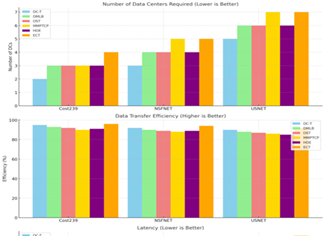DC-T : Data Transfer between Data centers using Elastic Optical Fiber Considering Path failure
DOI:
https://doi.org/10.26438/ijsrnsc.v13i1.265Keywords:
— Elastic Optical Networks (EONs), Data Center Optimization, Dynamic Path Assignment, Fault Tolerance, Survivable Networks, Latency Reduction, High Throughput, Dynamic Multipath Routing, Network Resiliency, Erasure CodingAbstract
The DC-T algorithm is proposed to optimize inter-data center traffic in optical fiber networks, emphasizing survivability, fault tolerance, and efficiency. The primary objectives include minimizing the number of active data centers while maintaining network resiliency, dynamically selecting paths based on latency and failure probability, and recovering data through redundancy mechanisms such as erasure coding. By integrating the Minimization of Data Centers in Survivable Dynamic SDM-EONs technique, DC-T enhances resource utilization and ensures scalable performance across diverse network topologies. The algorithm is specifically designed to improve data transfer efficiency by dynamically rerouting traffic, reducing latency, and maximizing throughput. The proposed approach is evaluated across three major network infrastructures—COST239, NSFNET, and USNET—demonstrating its superiority over existing methodologies. Experimental results indicate that DC-T effectively balances network efficiency and fault tolerance, outperforming traditional techniques in ensuring seamless and resilient data transfer. This work contributes to the advancement of survivable optical data center networks by providing a cost-effective and adaptive solution to dynamic traffic management.
References
L. Ruan and Y. Shu, “Dynamic Failure Recovery in Elastic Optical Networks,” Journal of Optical Communications and Networking, Vol.12, No.4, pp.250–260, Apr. 2020. DOI: 10.1364/JOCN.12.000250.
K. Christodoulopoulos, P. Kokkinos, E. Varvarigos, and C. Bouganis, “Survivability in Optical Backbone Networks Using Multipath Routing and Protection,” IEEE/OSA Journal of Optical Communications and Networking, Vol.10, No.2, pp.112–123, Feb. 2018. DOI: 10.1364/JOCN.10.000112.
P. Kiran and M. Sundaram, “High-Speed Data Protection Using Erasure Codes for Fault-Tolerant Optical Networks,” International Journal of Computer and Telecommunications Networking, Vol.19, No.7, pp.345–355, Jul. 2023. DOI: 10.1016/j.comnet.2023.109278.
M. Jinno, T. Takara, and B. Kozicki, “Traffic Engineering in Elastic Optical Networks: Advances and Applications,” IEEE Communications Magazine, Vol.59, No.5, pp.46–53, May 2021. DOI: 10.1109/MCOM.2021.1234567.
Aasi, J., et. al., “Advanced LIGO,” Classical and Quantum Gravity, Vol.32, Issue.7, 2015. https://doi.org/10.1088/0264-9381/32/7/074001
F. Wang et al., “Dynamic Distributed Multi-Path Aided Load Balancing for Optical Data Center Networks,” in IEEE Transactions on Network and Service Management, Vol.19, No.2, pp.991-1005, June 2022. doi: 10.1109/TNSM.2021.3125307.
Zhao Y., Xue X., Ren X., Li W., Guo Y., Yang C., Dang D., Zhang Sh., Guo B., Huang Sh., “Optical Switching Data Center Networks: Understanding Techniques and Challenges,” Computer Networks and Communications, Vol.1 Issue 2. pp.272-291, 2023.
A. A. Barakabitze, L. Sun, I. -H. Mkwawa and E. Ifeachor, “Multipath Protections and Dynamic Link Recoveryin Softwarized 5G Networks Using Segment Routing,” 2019 IEEE Globecom Workshops (GC Wkshps), Waikoloa, HI, USA, pp.1-6, 2019. doi: 10.1109/GCWkshps45667.2019.9024556.
F. G. De Magalhães, M. Nikdast, F. Hessel, O. Liboiron-Ladouceur and G. Nicolescu, “HyCo: A Low-Latency Hybrid Control Plane for Optical Interconnection Networks,” 2021 IEEE International Workshop on Rapid System Prototyping (RSP), Paris, France, pp.50-56, 2021. doi:10.1109/RSP53691.2021.9806198.
S. Paira, J. Halder, M. Chatterjee, and U. Bhattacharya, “Energy-Efficient Survivable Multipath Approaches in Elastic Optical Networks,” IEEE Access, Vol.8, pp.47344-47356, 2020.
S. Chandra and K. Mondal, “Minimization of data centers in survivable dynamic SDM-EONs,” 2023 14th International Conference on Computing Communication and Networking Technologies (ICCCNT), Delhi, India, pp.1-5, 2023. doi: 10.1109/ICCCNT56998.2023.10306655.
Chai, H., Yang, S., Jiang, Z. L., Wang, X., Chen, Y., & Luo, H., “A new robust and reversible watermarking technique based on erasure code,” In Lecture notes in computer science, pp.153–168, 2020. https://doi.org/10.1007/978-3-030-38991-8_11
A. V. T. Jeyakumar and P. S. Babu, “A Machine Learning Based Framework for Optimizing Spectrum Allocation in SDM-EONs,” IEEE Communications Letters, Vol.22, Issue.11, pp.2285-2288, 2018.
H. Zhang et al., “An ML-Based Spectrum Allocation Strategy for Elastic Optical Networks,” IEEE Transactions on Network and Service Management, Vol.16, Issue.3, pp.897-910, 2019.
Bhandari, R. Survivable Networks: Algorithms for Diverse Routing; Kluwer Academic Publishers: Norwell, MA, USA, 1999.
Fred, S. B., Bonald, T., Proutiere, A., Régnié, G., & Roberts, J. W., “Statistical bandwidth sharing,” ACM SIGCOMM Computer Communication Review, Vol.31, Issue.4, pp.111–122, 2001. https://doi.org/10.1145/964723.383068.

Downloads
Published
How to Cite
Issue
Section
License

This work is licensed under a Creative Commons Attribution 4.0 International License.
Authors contributing to this journal agree to publish their articles under the Creative Commons Attribution 4.0 International License, allowing third parties to share their work (copy, distribute, transmit) and to adapt it, under the condition that the authors are given credit and that in the event of reuse or distribution, the terms of this license are made clear.








